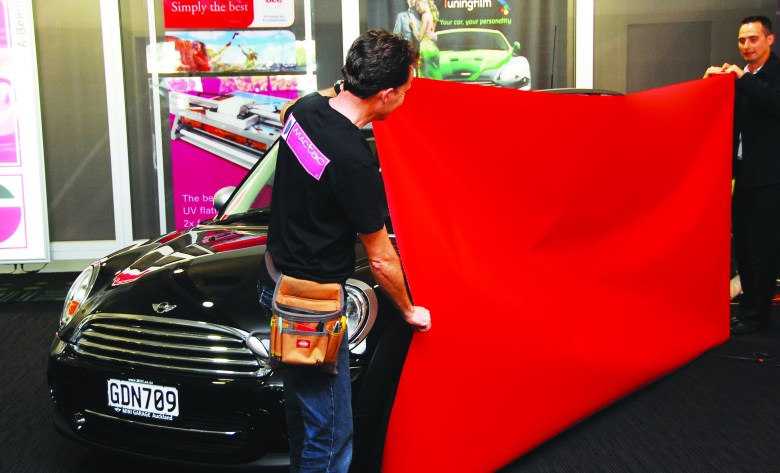
WHILE only making up a small part of the overall cost of a digital print campaign, a self-adhesive film never-the-less forms the essential foundation in every successful application.
If the wrong film is used and you encounter a problem, the cost to remove, to reprint, and to reinstall a graphic, as well as the time spent assessing the problem and dealing with the manufacturer, will impact on your profitability. It will affect your bottom line far more than spending time evaluating a film’s suitability prior to application or paying more for a quality product.
While you will need to consider a good number of issues when choosing the right film such as substrate compatibility, adhesive, and performance criteria, a question often asked about long term outdoor applications is “How long will the film last?” Before answering that question, you need to give consideration to two areas: film for computer cut lettering and film for digitally printed graphics.
With computer cut lettering, the coloured film is cut and applied to a substrate. In this sense, the film is the sign. Once the coloured film fades the message is lost. We choose a material on its durability rating (three year, five year, 10 year etc.) based on the expectation of the customer.
When choosing film for digital printing, the focus changes. The printable film is the substrate and the ink becomes the sign. The base film’s durability is no longer the only determinant of how long the graphic will last for.
What is also important is how long the ink lasts. Once the ink fades, the durability of the film does not matter beyond the fact that it performed to the life of the ink. If the print is to be laminated, then the durability of the laminate and the ink together will determine how long a sign will last.
An inexact science
So, how do we know how long any self-adhesive film will last? If only durability was an exact science.
When responsible manufacturers produce self-adhesive films, they use accelerated ageing and weathering tests and field experience in different environments to determine the durability rating of a film.
They perform the tests in a controlled laboratory environment using a predetermined, consistent set of conditions, which the manufacturer or testing authority deems as being representative of the climate the film will be used in.
No one has a crystal ball and, being able to replicate the exact weather conditions over one, five, or 10 years is basically impossible. What is also impossible to test with accuracy, is how some environmental factors will impact on the graphic such as pollution.
As vinyl can only be tested to a particular predetermined set of conditions, the published durability ratings should never be taken as an absolute.
What is also critical is that the vinyl purchaser considers not only the published durability of the product but any specific or non- standard conditions the vinyl may be exposed to.
The biggest influences on vinyl durability include:
- UV radiation- the amount of UV exposure and the intensity of the UV rays cause the film to break down over time.
- Temperature- vey high temperatures or very cold temperatures or extreme fluctuations in temperature all speed up the aging process
- Pollution and other environmental factors (abrasion, chemical contamination etc.)
The more a decal is exposed to these elements the faster the deterioration.
Even when you test a film’s durability to local conditions (country by country) it remains quite difficult to give an exact rating. In Australia and New Zealand north and south have very different climatic conditions. Even within a city, two signs on the same building can experience different conditions simply based on positioning.
What’s the angle?
The angle of the graphic also features as an important determinant of film durability.
When a manufacturer quotes a film as having a particular durability, usually the manufacturer bases that quote on a vertical application. If you apply the material to a non-vertical surface, then the durability rating will reduce in relation to the gradient. The greater the angle then the faster the deterioration. When you apply vinyl to a horizontal surface, it exposes the vinyl to damaging UV rays all the time unlike, say the side of a vehicle, where exposure time will change depending on the position of the vehicle.
For horizontal applications, some manufacturers will not offer any warranty or durability expectations or they simply do not recommend their product for this application.
You can see how the importance of having a strong awareness of this if you need to complete a full vehicle wrap; the roof, the bonnet, and some of the side areas will have horizontal, or close to horizontal, applications. Assuming that your five-year film will last for five years on the bonnet could lead to false assurances to the customer and a potential claim a few years later when the job fails to meet the customer’s expectations.
Another important point to understand when looking at the durability ratings on various films concerns the fact that these generally apply to unprinted film.
If your job requires you to complete a digital print, then the unprinted durability is irrelevant. You need to know what the durability of this film will be with ink and, if using a laminate, then the durability of the whole construction. You might be surprised to discover that the 10 year film you purchased has a durability of nowhere near 10 years once it is printed and applied.Every application is specific.
Taking these factors into account can help to better assess the potential durability of a product for your intended application and ensure that your customer is advised of reasonable performance parameters for their signage.
Comment below to have your say on this story.
If you have a news story or tip-off, get in touch at editorial@sprinter.com.au.
Sign up to the Sprinter newsletter
